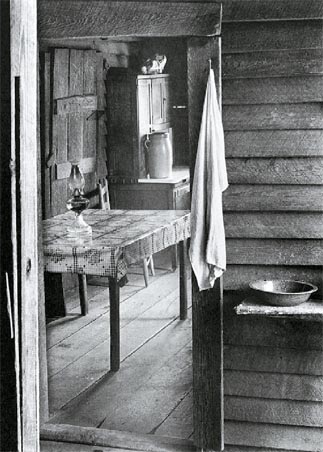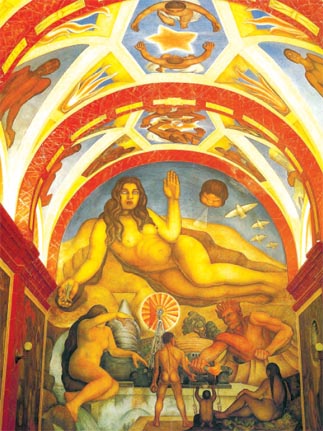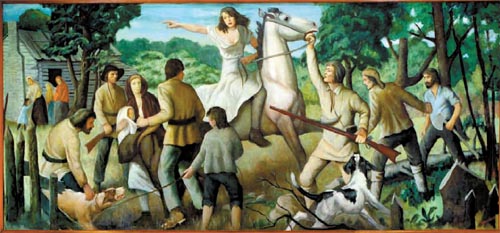What gets lost in the people’s art

“Home of Sharecropper Floyd Burroughs” (1935 or 1936) by Walker Evans (1903-1975), the United States Library of Congress
That comment was made by Edward Bruce (1879-1943), director of New Deal art projects under the Treasury Department in the early 1930s, according to David Lembeck’s article “Rediscovering the People’s Art: New Deal Murals in Pennsylvania’s Post Offices.”
As a result, it is now hard to find nudity in murals painted on the walls of U.S. public buildings in the 1930s.
As I said in the last article, the administration of Franklin D. Roosevelt, who came to office in 1933, launched public art projects as part of the New Deal, to counter the effects of the Great Depression. The first and best-known of the New Deal art projects employed artists to paint murals on federal government buildings, local post offices and other public spaces.
The idea was proposed to Roosevelt in a letter written by a painter, and the president thought it was brilliant. It would not only give jobs to artists in poverty but it would provide the working class, most of whom could not afford to visit museums, with a chance to see original works of art.
Roosevelt immediately brought the idea to the Treasury Department, which was in charge of the construction of federal buildings. (Later, the art project was shifted to the Works Progress Administration, which oversaw most New Deal projects.)
Bruce, who was in charge of art projects under the Treasury Department, had once been a successful lawyer and financier, but his deep passion for art led him to quit his job to become a professional painter before he was employed by the Treasury.
But for all of his passion, Bruce had a very conservative attitude toward the New Deal mural project. Erotic subjects were never allowed and nudity was considered erotic.
The article by Lembeck, a graphic designer who studied New Deal post-office murals, recounts a humorous episode about the project. When an artist known for using nudity in his work was hired to do a mural, an official from the Treasury’s Section of Fine Arts wrote a letter to the artist saying, “You have painted enough nudes in your life so that the painting of several more or less should not matter in your artistic career.”
Bruce and other New Deal mural-project leaders excluded abstract paintings and other paintings influenced by European modern art because they believed that the murals should be easily understood by the public. Paintings of controversial or political themes, such as war were also off limits.
In this sense, the New Deal mural project was quite different from the Mexican Muralist movement that had inspired it.

“The Liberated Earth” (1926-27), fresco by Diego Rivera (1886-1957), at Chapingo Chapel in Mexico City. [JoongAng Ilbo]
If there is any similarity between the New Deal mural project and the Mexican Muralist movement, it is that they both tried to maximize their folk identity. Artists engaged in the New Deal mural project were encouraged to adopt themes unique to America or related to American history. One example is the mural in Philadelphia’s Muncy Post Office, which depicts Rachel Silverthorne, a local heroine who warned settlers of an imminent attack by British-allied American Indians during the U.S. Revolutionary War.
With several limitations, works created under the New Deal mural project were largely innocuous. Murals that were even slightly provocative drew objection from people in cities where they appeared and thus were rather moderate. This brought the criticism that the project was useless and took away an artist’s freedom and creativity. In fact, since avant-garde works were excluded from the project, the New Deal murals neither exerted much influence in American art history nor produced any notable works.
The artworks created under the New Deal project reflected the larger debate about whether the New Deal was effective or not. The Great Depression ended with the outbreak of World War II and there is a considerable number of scholars who argue that the war was more influential in ending the Great Depression than the New Deal policies were. Although the United States was not directly involved in the war at first, it was a supplier of war materials and restoration goods. And because tens of millions of young people were sent to Europe as part of the draft, the unemployment rate diminished in an instant.
Some laissez-faire economists even consider the New Deal as an obstacle to the United States’ recovery from the Great Depression. They believe there were limits to financial outlays and that the government delayed a more organic recovery by intervening and suppressing individual creativity and competition. This idea is also reflected in the fact that there were no creative masterpieces produced under the New Deal mural project.

“Rachel Silverthorne’s Ride in August 1778” (1938) by John W. Beauchamp (1906-1957) is a mural in the Muncy Post Office in Pennsylvania. Provided by Wikimedia Commons
But there were masterpieces produced during the Depression. These, however, were produced under the documentary photography project initiated by the Farm Security Administration. That’s because the administration focused more on documentation than on promoting social security policies. That allowed photographer Walker Evans, who was one of the artists of the photography project, to capture the house of a tenant farmer from an artistic perspective, rather than a commercial one.
Public art projects like the one initiated by the FSA can be successful, but success is relatively hard to achieve. Public art, which is financed with taxpayer money, needs public agreement. But it is impossible to have a referendum on each and every work of art, so it is up to the government or a public committee to decide whether a work deserves support; therefore it is their opinions that are reflected in public art projects. In the process, freedom or creativity are often destroyed.
That begs the question of whether public art really is useless, as critics of the New Deal mural project contend.
In a contemporary capitalistic society, the issue of art being subordinated by capital is of great concern.
Many people in the art world worry that art will become a commodity through art auctions and that the art industry will be controlled by the preferences of the affluent people who can afford to buy it.
However, I believe that selling artworks at an auction, where the artwork goes to the highest bidder, is fair. The price of an artwork in a market economy represents not only its material value but is also a measure of the buyer’s desire for the work. The only problem is that money is not distributed equally among the public and therefore the preferences of people without wealth are not reflected in the art market.
People without money should also be able to enjoy fine art, which points to the need for public art.
The question of to what extent the art world should rely on the market or let the government intervene is not simply a matter of economic policy but cultural policy as well. Both the market and government subsidies may go a long way toward diminishing art, but the reality is that art cannot exist without either. This is the unsolvable dilemma in art.
By Moon So-young [symoon@joongang.co.kr]
Related Korean Article
정부 간섭 많았던 뉴딜벽화, 창의적 걸작은 못 남겨
문소영 기자의 명화로 보는 경제사 한 장면 <18> : 대공황이 불러온 뉴딜아트 <下>
“벽화에 누드를 그리는 사람은 뇌를 좀 검사해봐야 돼!”라고 에드워드 브루스(1879~1943)는 일갈했다. 그는 1930년대 초에 미국 재무부 산하 공공미술사업계획(Public Works of Art Project)을 지휘하고 있었다. 덕분에 30년대 미국 공공기관 벽화에서 나체 인물은 찾아보기 힘들게 됐다. 아메리카 원주민을 제외하고는. 1933년 집권한 프랭클린 루스벨트 행정부는 대공황을 타개하기 위한 뉴딜(New Deal) 정책의 일환으로 예술 관련 뉴딜도 추진하고 있었다. 미술 관련 뉴딜의 첫째 사업이자 대표적인 사업은 국가에서 화가들을 고용해 우체국 등 공공기관에 벽화를 그리게 하는 것이었다. <사진 2>
한 화가가 루스벨트 대통령에게 직접 편지를 보내 이 프로젝트를 제안했고, 루스벨트는 기막힌 아이디어라고 감탄했다. 빈곤에 시달리는 화가들에게 일자리를 줄 뿐 아니라 미술관에 갈 시간적·금전적 여유가 없는 서민들도 진짜 그림을 실물로 볼 기회가 아닌가? 루스벨트는 곧 재무부에서 이 일을 담당하도록 했다. 재무부가 연방 건물의 건축을 책임지고 있었기 때문이다(나중에 벽화 프로젝트는 뉴딜 사업을 총괄한 공공사업진흥국-Works Progress Administration: WPA-으로 넘어갔다). …
http://sunday.joins.com/article/view.asp?aid=19845










with the Korea JoongAng Daily
To write comments, please log in to one of the accounts.
Standards Board Policy (0/250자)